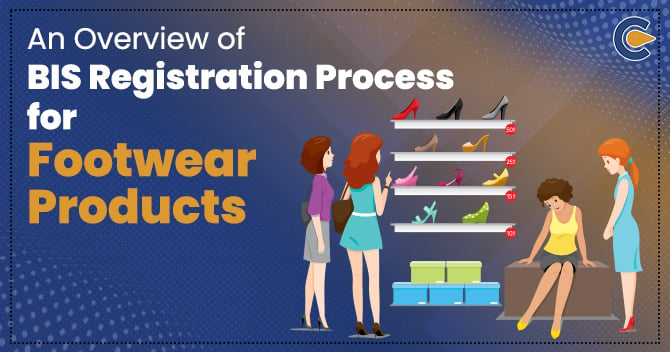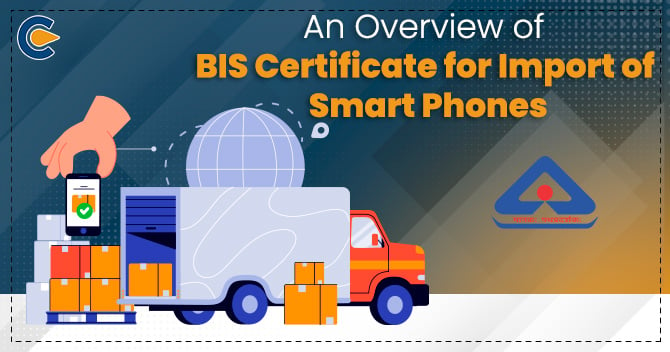The BIS (Bureau of Indian Standards) is the Government body involved with conformity assessment, Quality Assurance of products, services, processes, and Standardization of products. As per a recent notification by the DPIIT (Department for Promotion of Industry & Internal Trade)[1], all footwear manufacturers will need to obtain BIS Certificate, and all the Footwear needs to comply with the Indian Standard and get the ISI Mark (Standard Mark) under a license by the Bureau. The department has introduced three quality control orders that will cover and lie Footwear made from rubber or polymeric material, leather & other materials and PPE footwear in the compulsory certification of BIS. In this article, we know the BIS Registration Process for Footwear Products.
The three quality control orders are-
- The Footwear made through Leather & other raw material (Quality Control) Order, 2020;
- Personal Protective Device – Footwear (Quality Control) Order, 2020;
- The Footwear is made through all-Rubber & Polymeric material and components (Quality Control) Order, 2020.
List of the Footwear Products Which Require BIS Registration Certificate
Following is the list of footwear products that require a BIS Registration Certificate:-
| Indian Standard | Name of Footwear |
| IS 1989 (Part 1): 1986 | Leather safety boots & shoes. |
| IS 3736: 1995 | Canvas Boots Rubber Sole. |
| IS 3735: 1996 | Canvas Shoes Rubber Sole. |
| IS 3736: 1995 | Safety Rubber Canvas Boots for Miners. |
| IS 14544: 1998 | Leather safety footwear with direct moulded polyvinyl chloride (PVC) sole. |
| IS 11226: 1993 | Leather safety footwear has a direct moulded rubber sole. |
| IS 17012: 2018 | High ankle tactical boots with PU – Rubber sole. |
| IS 15844: 2010 | Sports footwear. |
| IS 17043: 2018 | Derby shoes. |
| IS 17037: 2018 | Antiriot shoes. |
| IS 5557: 2004 | Industrial & protective rubber knee & ankle boots. |
| IS 5676: 1995 | Moulded solid rubber soles & heels. |
| IS 5557 (Part 2): 2018 | All rubber gum boots & ankle boots. |
| IS 6664: 1992 | Solid PVC soles & heels. |
| IS 6664: 1992 | Rubber microcellular sheets for soles & heels. |
| IS 6719: 1972 | Solid PVC soles & heels. |
| IS 10702: 1992 | Rubber HawaiChappal. |
| IS 12254: 1993 | Polyvinyl chloride (PVC) industrial boots. |
| IS 6721: 1972 | PVC sandal. |
| IS 11544: 1986 | Specification for slipper, rubber. |
| IS 13995: 1995 | Unlined moulded rubber boots. |
| IS 16994: 2018 | Footwear for men & women for municipal scavenging work. |
| IS 13893: 1994 | Polyurethane sole, semi-rigid. |
| IS 16645: 2018 | Moulded plastics footwear- Lined and Unlined polyurethane boots for general industrial use- Specification. |
| IS 15298 (Part 2): 2016/ IS 15298 (Part 3): 2019/ IS 15298 (Part 4): 2017 | Personal Protective Equipment – Footwear. |
Benefits of BIS Registration
There are many benefits of BIS Registration for your business:-
- It provides you a ground for Total Quality Management, i.e. TQM.
- Get rid of overhead expenses used to manufacture the final products.
- Ensure better utilization of minerals & resources.
- It serves as solid proof of product quality.
- Facilitate global recognition, thereby ensuring access to untapped & overseas markets.
- Aids firm to Improve market reputation.
- Enable firm to deploy bespoke quality management.
Documents Required for BIS Registration Process
Following are some vital documents that are required for BIS Registration Process:-
- Identity Proof;
- Factory Registration Documents and details;
- Manufacturing process flow chart;
- Adequate testing facilities;
- Laboratory testing report & other details according to BIS norm;
- Information of Authorized Signatory & other related documents.
- Quality Control Parameters & their records.
BIS Registration Process for Footwear Products
As per the Department for Promotion of Industry & internal Trade (DPIIT) Quality Control Order on Footwear Products, 27 products have been brought under compulsory BIS Certification. Firstly, you need to identify the Indian Standard for your footwear product. After that, you must create login credentials on the BIS Manak online portal to apply for BIS Registration for your footwear product.
The following are the normal BIS Registration process for Footwear Products:-
- Documentation before submission of application.
- Submit the application with the required documents.
- Scrutiny of an application under BIS officials.
- Nomination of Inspection officer for Inspection from BIS;
- Inspection of manufacturing premises by BIS Inspection officer.
- Sample draw for independent testing
- Sample testing by BIS Approved Laboratory.
- Grant of BIS License for footwear products.
New update on BIS Registration Process
As per the domestic footwear industry’s request, Central has postponed the implementation of quality control orders from a year to 1 July 2022. The order makes it mandatory for manufacturers, traders and importers to get BIS License (Standard Mark) for their footwear products. The Authority for Promotion of industry & internal trade, by separate order on 20 June 2022, said it had been decided to amend the implementation date.
Conclusion
BIS Certification for any product is a challenging and drawn-out procedure that starts with product development and validation. Lastly, to use the standard ISI mark on Footwear, footwear makers and importers must first obtain a BIS Certificate or Licence. It is prohibited to sell shoes in the nation without the ISI brand.
Read our Article:How to Obtain BIS Certification in India?













